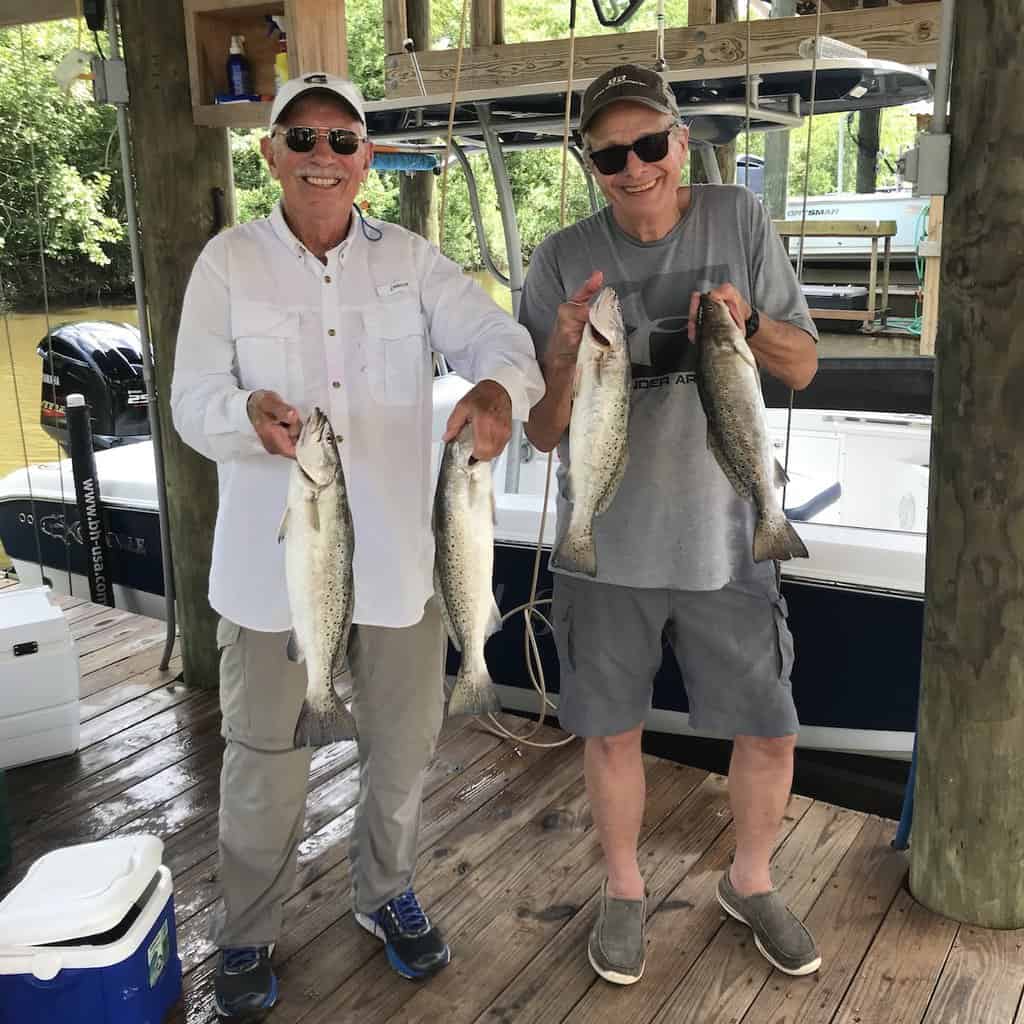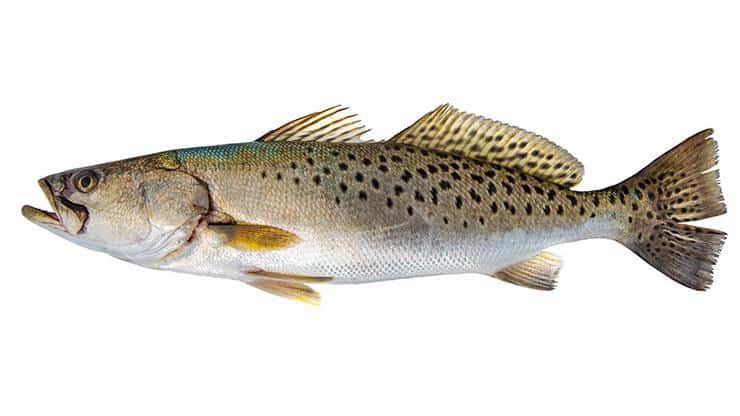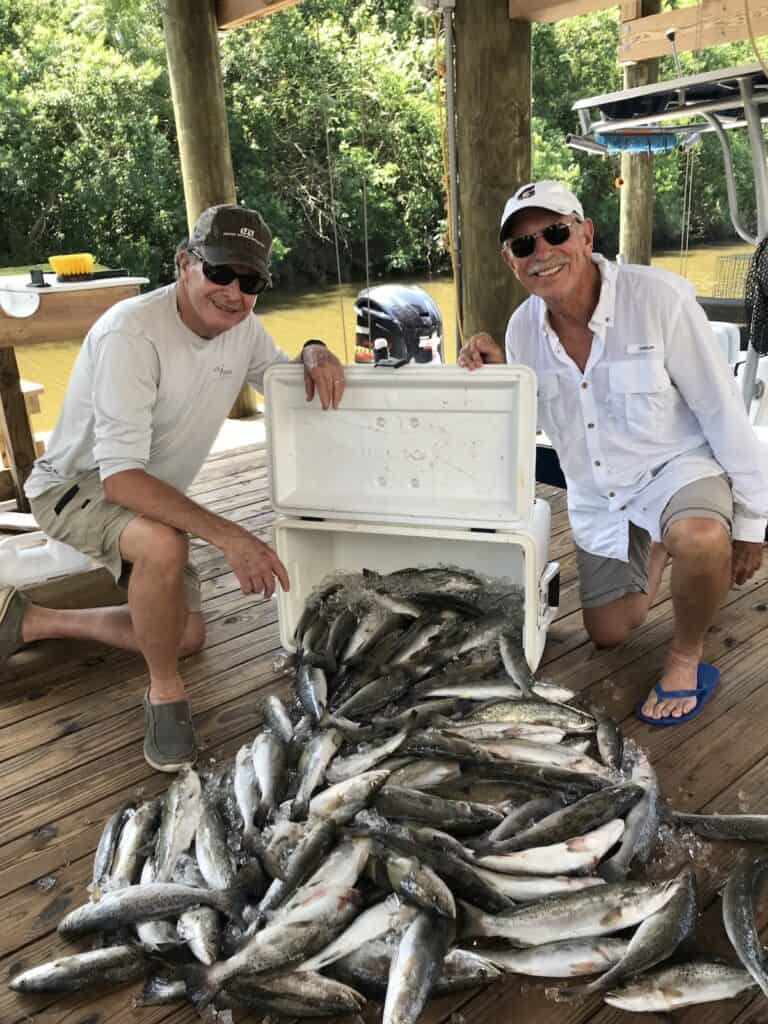Speckled trout are a hard-fighting but delicious species beloved by anglers, an incredibly popular gamefish in brackish and salt waters along much of the Gulf and Southeastern U.S. coastline.
Fun to catch, these fish travel in schools, moving from salt water to coastal marshes throughout the year and providing anglers a myriad of locations to fish for them.
This article covers the best ways to catch speckled trout by taking a deep dive into the fish and, of course, the fishing tackle, techniques, and expert tips used to catch them.
What is a Speckled Trout?
Often referred to as spotted seatrout, speckled trout are predatory, mostly silver fish that reside across the Atlantic seaboard, across the Gulf states, and down to the shores of Mexico.
Also nicknamed “trout” or “specks” by many anglers, speckled trout are not related to the freshwater trout you caught that summer in Montana. Instead, seatrout are related to saltwater croaker and drum.
Speckled trout have several prominent features that can help anglers distinguish them from other fish.
First, they have several distinct canine teeth to grab and hold their prey. They also have an elongated dorsal fin separated into sections and a back full of distinctive spots.
Speckled trout also lack the barbels most seatrout have on their chins. Usually a silvery gray, trout have been known to shift to a coppery hue in muddy or freshwater.
Speckled trout range in size from 1-5 pounds in most areas. They occasionally exceed 10 pounds, with the world record being 17.7 pounds. Male speckled trout can reach about 19 inches, while large females can measure over 25 inches.
Where to Find Speckled Trout
A middle-of-the-food-chain predator, speckled trout are a critical component of the ecosystem from the marshes of Texas and Louisiana, around Florida, and up the Atlantic seaboard.
They commonly inhabit shallow bays during the warmer months of spring and summer while moving into deeper waters off the Gulf or southern Atlantic coastlines during the fall and winter.
Trout prefer to stick around seagrass and oyster beds, both of which are rich with bait. An open bay or wide canal filled with underwater structures like these beds are solid choices to fish. A fish finder is handy to locate these prime spots.
What Do Speckled Trout Eat?
In a word: shrimp. If there is one food group that spotted seatrout don’t pass up, it’s shrimp. The fish will chase schools of shrimp through marshes and canals, feeding alongside the mudbanks and seagrass beds where shrimp hang out.
Speckled trout will also consume various baitfish such as mullet, minnows and pinfish, and crustaceans like sand fleas and crabs.
How to Catch Speckled Trout
A one-size-fits-all approach to fishing for specks will at times fail you, so I’ll provide you with several fishing methods that will catch speckled trout pretty much wherever and whenever you find them.
A perfect example of this was a trip that my grandfather, Thom Pelle, took not long ago out of Hopedale. He’s an expert angler with over 60 years of experience in speckled trout fishing, and he’s shared many of his tricks with me.
On the Hopedale outing, the catching wasn’t as quick as Thom knew it should be. He knew when to switch to plastics despite every other angler on the boat, and those fishing on nearby boats, using shrimp under a cork.
Thom began catching trout at a 3:1 ratio to other anglers because his experience told him to change it up for a better bite.
“Once they saw how I was catching them, everybody switched over,” he told me after the trip. “We limited out in under 2 hours.”
That said, popping corks and other rigs will often be just the ticket to catch more speckled trout. It will depend on the day, so it’s best to come prepared with the knowledge and tackle for any situation.
Here’s a look at the best techniques.
Popping Cork
An easy setup to work, anglers use a sliding cork with rattles, a weight, and a hook to angle the middle of the water column. When baited with plastics or natural bait, this rig is simple to use and requires a modest amount of skill from the angler.
Single/Double Rig
This rig employs weighted plastics with embedded hooks. Anglers retrieve the soft plastics across bodies of water at varying depths, depending on both weight and speed of retrieval.
This setup requires the most input from anglers but can yield some of the best results.
Carolina Rig
A relatively simple rig for speckled trout, this setup includes a sinker and one or two hooks attached by a leader, which float the bait into the water column. A Carolina rig is an incredibly effective setup for surf fishing, and it is what I have typically used to catch the most speckled trout while fishing off the beach.
Topwater
Probably the most interactive rig for speckled trout, topwater lures are often associated with fishing for bass or redfish, but these lures also can bring in the larger trout. Excellent for working shorelines and grass beds, topwaters are one of the most enjoyable speck-fishing setups.
Speckled Trout Lures
Lures are the more proactive approach when angling for speckled trout.
Instead of placing bait in the middle of the water column and waiting for speckled trout to come to you, it’s often more effective to work shorelines and structures with a lure. There’s a wide range of lures out there, but if you’re targeting sea trout, select smaller lures than you would pick for catching redfish.
A good rule of thumb is that if a lure is a good size for a midsize freshwater bass, it’s probably perfect for speckled trout.
Soft Plastic Lures
Soft plastic lures usually come with a body that has an integrated hook and weight attached, similar to a jig head. This design is easier to cast and keeps the bait moving at a realistic angle in the water during retrieval.
Plastic Minnows
Coming in a variety of shapes, colors, and styles, plastic minnows can be a lethal lure when angling for speckled trout.
Paddle tails, split tails, and oblong twitch baits are all excellent choices to work shorelines, grass, and oyster beds.
Usually 2-4 inches in length, these fish-imitating plastics are often laced with glitter to enhance their visibility in the water.
Plastic Shrimp
Great for working beneath a popping cork, plastic shrimp are often scented and closely resemble real shrimp.
Often flecked with glitter and molded with a colorful tail, these are an excellent choice to throw when fishing around schools of shrimp.
Note about soft plastics: Spoons attached to soft plastics can add to their allure with underwater vibrations and flashes.
Topwater Torpedos
Though not usually the first choice of lures for speckled trout fishing, topwater lures shaped like torpedoes can be incredibly effective and a great way to cover lots of water when trying to locate speckled trout. Heddon is a common brand for this type of lure.
Shorelines or grassy beds are all solid places to find speckled trout, and the disturbance that a topwater torpedo or minnow can lure a cautious trout out of the cover to attack your lure.
Jig Heads
Jig heads are excellent for angling around structures or over grass flats.
To correctly angle with a jig, it’s all about retrieving and then stopping to let the head fall, which is where 90% of the strikes occur.
Most often baited with plastic minnows or shrimp, jig heads are easy to cast and are an excellent rig for novice trout anglers.
Bait Fishing for Speckled Trout
Sometimes, plastic lures are not the best answer when it comes to catching speckled trout, despite the wide variety of artificial options. Tried and true members of the food chain can yield excellent results when plastics fail.
Here are some of the best natural baits:
Shrimp
The most commonly used bait when angling for speckled trout, anglers can often find the fish feasting on schools of migratory shrimp.
Live Shrimp
If anglers can get their hands on live shrimp, the bait’s struggle and twitches while on the hook will trigger the predatory instincts of the speckled trout. Great to work under a cork or on a Carolina rig, live shrimp should always be an angler’s first choice of bait for trout when available.
Dead or Frozen Shrimp
While these will still work well, dead shrimp don’t yield the same results as live shrimp. Best used on a Carolina rig, these baits will still catch speckled trout fished under a popping cork. Use them as a substitute when live shrimp are unavailable.
Crab
Most commonly used when angling for redfish, speckled trout also will bite on small crabs or pieces of larger ones thrown under a popping cork or on a Carolina rig. In marshes heavily populated with crabs, anglers are more likely to succeed with this bait for speckled trout than in other locations.
Minnows
When shrimp are out of season, minnows work well on a Carolina rig. I have caught many speckled trout along with redfish on a Carolina rig using small minnows. Live minnows ranging from 2 to 4 inches are perfect when angling for specks. Hook the minnow through the lower lip to allow it to move freely and trigger the trout’s predatory response.
Note about natural bait: Whenever you can catch your own bait near where you’re fishing, using a cast net, I find these baits work better on Carolina rigs.
Where to Fish with Bait
Because speckled trout are transient fish, anglers will find them in different locations throughout the year. Some of the best places to incorporate bait into your angling techniques are when casting into the surf from beaches or rocks, fishing around platforms and rigs, or angling in marshes.
Because speckled trout tend to be found in the middle of the water column, suspending bait beneath a popping cork or on a Carolina rig can place the shrimp, crab, or minnow in the strike zone.
Especially when there are lots of bait fish or shrimp in the water, incorporating bait can be the deciding factor for a successful sea trout fishing trip.
Speckled Trout Tackle
Hooks
The most commonly used hook size is a 1/0 circle hook, which is also called a J hook.
Robust enough to handle larger redfish that might take your bait, the 1/0 circle hook is the perfect size to rig up with minnows or shrimp.
Treble hooks are often used on Carolina rigs, and sometimes under popping corks. The best size for these is a number 3 or 4. The Mustad KVD Ultrapoint is an excellent treble hook in this size, spacing out its points to help prevent the fish from swallowing the whole rig.
Sinkers
The majority of weights used when angling for speckled trout are egg- or pyramid-shaped lead for Carolina rigs. The weight secures the rig to the bottom while allowing the bait to float freely in the water column above.
Occasionally, premade popping cork rigs will have small lead balls beneath them to keep them upright in a current or waves. This alignment ensures that the hook sits vertically in the water column, improving its ability to hook fish.
Jig Heads
Jig heads have lead formed in either a sphere or replicating a fish head with a hook protruding from the bottom. These are typically baited with plastics and used for jigging for speckled trout.
Corks
Popping corks are an essential piece of tackle for any speckled trout angler. They allow anglers to control their bait’s movement and indicate when a fish strikes. These floats often come in highly visible shades like bright green or orange on a premade setup. Choose small to medium corks for speckled trout.
Fishing Rods
When selecting a rod for speckled trout, anglers should look for fast action, medium power rods between 6’2″ and 7’6″ in length. This rod size allows anglers to handle all sizes of trout and a few other species of fish that may bite alongside trout.
Graphite rods are better for marsh and inshore fishing, while open water anglers often prefer more rigid fiberglass rods.
Fishing Reels
Both bait caster and spinning reels work well when angling for speckled trout. However, anglers who are uncomfortable with bait casters, which require more expertise and practice, will fare better with spinning reels. The best reels are usually one-piece, capable of handling line between 6- and 15-pound test, and have 4+1 bearings.
Fishing Line
Fishing line that is 8- to 10-pound test is ideal for speckled trout. Anglers also utilize 6-pound braid, a woven line that tends to hold up better around structures with sharp edges, like platforms and rocks. No matter which line you use, tie on a monofilament or mono carbon leader in 15-pound test to attach your mainline to your lure.
Where to Catch Speckled Trout
Speckled trout are seasonal fish, and anglers may find that certain fishing holes only produce part of the year. However, there are a few key locations that anglers can target to better their chances of success.
Rigs or Platforms
Shallow water oil rigs, platforms, and other structures in open water are excellent locations for speckled trout.
Oyster Reefs
One of the most common places to catch speckled trout is over oyster reefs in marshes or in open water near marshes.
Grass Beds
You’re likely to find speckled trout in grass beds during the spring and fall. If shrimp are nearby, you have stumbled on a gold mine.
Marsh Grass/Shoreline
Water clarity is important in this instance. Water in marshy areas that is the color of chocolate milk means there is lower salinity content. That type of water is more favorable to redfish and bass than speckled trout.
However, greener water means a higher salinity content, and in these conditions anglers will likely find speckled trout along the shoreline in search of crabs, minnows, and shrimp.
Best Time of Year to Catch Speckled Trout
Fall
Fall can be one of the best months for speckled trout fishing. Shrimp migrate during the fall, and as they are a primary item in a speckled trout’s diet, the fish will follow the shrimp. Shrimp relocate from the marshes into open waters during the colder months.
Speckled trout will feast on these crustaceans for as long as water temperatures allow as the trout fatten up for the coming winter.
Winter
During the winter, it’s almost impossible to find trout in the marshes, although large trout have been caught alongside bull reds in duck ponds.
Because speckled trout are extremely susceptible to changes in water temperature, they eat when the water warms and lethargically hide in deeper water when the temperature dips. For best success in the winter, anglers should seek open water over reefs to locate feeding sea trout.
Spring
During early spring, before spawning in late spring and summer, trout don’t school and are often scattered throughout the marshes. Because speckled trout don’t school up in predictable places during the early spring, it’s one of the more challenging times to catch them in numbers.
One of the best springtime fishing tips is this: If you can find birds diving on shrimp, there will likely be speckled trout biting in the area.
Summer
From mid-April through August, anglers will find trout on marshes’ outer banks or near bay entrances. Summertime spawning season is a time filled with activity. Speckled trout will attempt to avoid the heat of the day, so get on the water early or fish late to increase your odds of catching active fish.
Summary
Speckled trout are some of the most fun fish to catch along the southern coastlines of the United States. You’ll find them in good numbers from the Carolinas to South Texas and on into Mexico.
So whether you call them speckled trout, spotted sea trout, or something else, these fish are delicious, hard-fighting, and plentiful.
Knowing the right bait and tackle to use, how to change your tactics for the situation and the season, and the areas where you’ll most likely find speckled will help you fill your ice chest with specks in no time.
Where to Catch Speckled Trout



